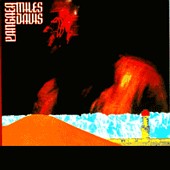|
Fissuring the World Electric: Miles
Davis and Pangaea
by
Joe Johnston
3/28/2002

About
six or seven years ago, at my then-favorite record store, I must
have looked at Miles Davis’ Pangaea a hundred times. Every trip I made there, with my usual stacks
and stacks of trades, I made a point of looking for it, and the
same copy was always there. I
was studying geology at the time and cracked up at the unusual
title: Pangaea is the prehistoric original super-continent that
later broke up into the seven we know today.
The double-album contains only two songs, Zimbabwe and
Gondwana. I must have been scared of a double album with only two songs, because
I never came close to buying it, although by that time I was a
die hard fan of Bitches Brew.
My usual routine would be to pick it up, stare at its strange,
electric cover, marvel at the title, make a crack to my record
shopping buddy about how “Miles must be getting back to EVERYONE’S
roots calling his album Pangaea,” then put it down and
leave.
When
I finally got re-interested in Miles about a year ago, Pangaea
was the first album I bought.
I was a little more than surprised to realize my not-so-funny
crack had come true: Miles in fact does get back to everyone’s
roots.
Recorded
at the evening concert at Osaka Festival Hall, Japan, on February
1, 1975, Pangaea is the last official recording Miles made
before retiring to cocaine for 5 years.
It also represents the farthest out he would ever get with
electric music. Featuring
his densest, fattest, tightest band, it is a case study in sonoric
texture and a balls-to-the-wall rhythmic funk fest.
It is the soundtrack of continental drift, one of a few
true examples of what can only be called World Music.
Although
it contains several “songs” regularly featured in the the live
Miles repertoire at the time, disc one is one track, Zimbabwe. Beginning with the tune known to the band as
“Turnaroundphrase,” Miles and company throw out all preconceived
notions of proper jazz and/or rock and thunder away for 40 minutes.
Al Foster’s drums machine-gun their way into
the stratosphere, setting up a plateau for the rest of the band
to rumble, shudder, build up chords only to deconstruct them,
crunch and crackle on top of.
Miles enters, James Brown-like, at a minute and a half
into the piece. He was
full-on wah-wah pedal at this point in his career, giving him
a unique voicing that could make his trumpet seem to change from
a trumpet to a singer to a guitar and back.
Remember, Miles was the among the first trumpet players
to not use vibrato in jazz, a style that set him apart from the
Louis Armstrongs and Dizzy Gilespies of the 40’s, 50’s and 60’s.
With his wah-wah, he crunches entire passages into jiggling,
vibrating land-masses floating across the Earth’s crust.
Sonny Fortune then takes over the continent smashing with
alto saxophone, in a style that is many things at once…free, bluesy,
traditional, trilling. Scorching the earth more than Davis and Fortune combined, though,
is Chicagoan Pete Cosey on guitar.
Much like their presentation of alto saxophones to John
Coltrane and Pharaoh Sanders when they toured Japan, The Yamaha
Corporation had given Cosey their newly invented guitar synthesizer
upon his arrival. A conservative
man might have translated the Japanese manual into English before
plugging it in, but Cosey tore into this new magic sound box as
if it were a rocket ship given to an adolescent Buck Rogers fan
playing in the schoolyard. He
is able to coax the most incredible crunching outer space wahs
and distorted rumblings from the synthi, never imagined before
its creation, and seldom realized since. Mtume plays a smattering of auxiliary percussion,
mainly congas, representing fire and brimstone, pyroclastic percussion
for the people. He never
sabotages the ensemble like Airto did with Miles in the early
‘70s; his drums are rooted in African grooves but made more street
like, as if he could be on some New York street corner patting
the bottoms of buckets for the pedestrians.
Rounding out the mix is Reggie Lucas on rhythm guitar and
Michael Henderson on bass. Reggie’s rhythm rarely cruises out in front
but is always sensed, subconsciously, like waves in front of Australia
as it slowly cruises south. Henderson’s
bass vamps are the rock of the band, loud, Gibraltar-like, heavy,
thundering. Zimbabwe is a dissertation of funk density,
at first listen a simple Sly Stone-like jam, but with each subsequent
listen a complicated mass of metamorphic groove, layer upon layer
upon layer upon layer of rocky mineral shaken up and stirred by
the gods.
Disc
two is Gondwana, coming in at 45 minutes. It begins with Fortune on flute, setting up
a very beautiful psalm-like story.
The rhythm section enters and drops out, re-enters and
remains, rising in intensity as the prayer continues.
Miles appears at around 6 minutes with a painful, sorrowful
solo, sounding like an apology to a higher power.
He sometimes switches to organ, fooling and feeling around
for chords, while the rhythm continues, goading the psalm on,
fearful that it might make a leap too great in the wrong direction,
but ever moving outward, upward, in volume, intensity and direction.
Gondwana is the question to Zimbabwe’s answer,
a 45 minute love song to the Earth, the gods, and the primordial
soup.
It
was said of Miles’ playing
on Sketches of Spain that he “had rarely soloed with such
concentrated intensity.” The
same could be said for Gondwana, with one slight addendum:
rarely has Miles soloed with such concentrated, intense pain.
Miles the man was a wreck by 1975, with a replaced hip,
two recently-healed severely broken ankles, arthritis in all his
joints and a cocaine-relieved bad back.
You can almost hear his joints popping out of his trumpet,
his ankles cracking with each high, wah-wahed note, his backbone
cringing to stay upright with each low flutter.
Gondwana is a prayer offered up for the gods from
a tiny, broken, beaten shell of a man. A prayer from a man’s last breath.
This
is world music, not the “World Music” of Columbia House and Tower Records, but the true
category-less music of the world. So
much of what is called World Music is for the psuedo-intellectual
crowd. Take a trio of Tibetan
singing bowls, add some funk bass, and play it on NPR. Then
we can all feel happy that we’ve multi-culturalized ourselves. Miles and Pangaea take a different, convoluted,
more difficult route. Pangaea
is the original super-continent. Gondwana was the first major shoot-off of Pangaea, the one containing
what is now Africa. Zimbabwe,
in 1975, was still the white-controlled British Colony of Rhodesia. The
concert was presented in Japan by an American band. Mtume
is African and South-American in his sound, but never straying
too far from the streets of New York. Henderson
played for Motown and represents the street funk of the Funk Brothers
(the original Motown house band). Foster
is pure rock and roll, with as much rhythm in his little finger
as Keith Moon had in his lower intestine (excluding the colon). Lucas
is the illustrator, a sweeping impressionist of all kinds of music. Fortune
is all blues: Vocalion to Chess, with just a dash of English blues
imitation, circa 1966, not to mention the soul of Stax. Cosey
is from outer space, Karlheinz Stockhausen and John Cage with
a pinch of Hendrix rolled up into a comet from the Crab Nebula
and crash landing in Chicago. Above all this is Miles, ever Miles, always
Miles. Miles the innovator. Miles the storyteller. And Miles the leader. What Teo Macero did with the tapes from the
early 70’s, cutting them up and editing them like so much bits
of film, Miles does with his hands, or a glance, or a micro-second
musical clue. The starting, stopping, phrase changing and
mix-fucking-up on this record is incredible…the band knew what
to look for, and follow the leader with all the attention of an
extremely well-tipped waiter.
Miles is the preacher, assembling his disciples with all
their individual input into a textured, continent shifting single
unit, with results far greater than any one individual member
ever thought possible.
This
music of the world works because all these disparate styles and
stories blend together and soar like a synergistic flock of ravens.
Rarely clashing, and rarely sounding like tossed salad
World Music with equal parts New Orleans Jazz, Norwegian Death
Metal and Aboriginal didgeridoo, the players (and styles they
represent) on Pangaea combine to form something new, something
anyone can take something from if they care to dive in.
A
few words to the critics of this admittedly difficult period in
the career of Miles Davis: there are those who charge that Miles
“sold out” with these records.
As I understand it, to sell out requires first that you
sell, and (aside from Bitches Brew) very few of Miles’
‘70s albums sold anything at all. Pangaea was only sold in Japan until
1991, and Agharta, the album from the afternoon concert
of the same day, wasn’t released anywhere until 1991. The
music may be rooted in the popular funk rock of the time, but
Miles had a hard time getting anyone to listen to it, white or
black, young or old. Herbie
Hancock’s watered-down, easily consumable by the average 4th
grader (Sextant excluded) version sold much better.
Other
fans of Miles (Amiri Baraka and Anthony Braxton to name a couple)
at one time charged that he let the Black Power movement down
by not continuing in the free tradition set up by Coltrane, Coleman,
Ayler and the like. It’s
incredibly naïve to think that something as subjective as music
can change a people (a person, sure…Miles and his music
have changed me numerous times). But it was never Miles’ intention to bring
about social change to one group.
That was never the goal, so judging the music for not delivering
what it was never meant to deliver is wasted and misplaced energy. He funked it up for himself, for his ears, with a sideline take-it-or-leave-it
hope of gaining more of a black audience.
And
Rock and Roll is black music. Robert Johnson to Chuck Berry to Motown to
Jimi Hendrix and beyond. Could
anything be more black, R&B, soulful, and “walking-the-bar”
bluesy than Sonny Fortune’s first solo on Zimbabwe?
After my first few listens, this solo stuck
out as a low-point on the album.
It sounded, at first, like Simpleton Sax blowing through
the usual changes. I was hoping for more of a Wayne Shorter or
John Coltrane in Sonny Fortune.
The more this album works on me, though, the more it sticks out as a charge, a rallying cry for the audience,
a crazy, dizzying lighthouse beacon above the even more dizziness
of the rhythm. A bluesy,
black touchstone for those moments when the dense funk becomes
too dense.
But
this isn’t just black music. This is the music of the world, a tribute to a (sadly now fairly
unfathomable) one-land-mass, a psalm for the ground we ALL walk
upon. A study in dense textures and colors for the
world to climb in and dance along with.
An ugly-beautiful masterpiece of imagination. This is out-of-control dense funk kept in check by a firm hand.
Miles gets back to the roots of everyone who has ever walked
this earth and serves up a continent shifting funk masterpiece.
It comes recommended.

|

